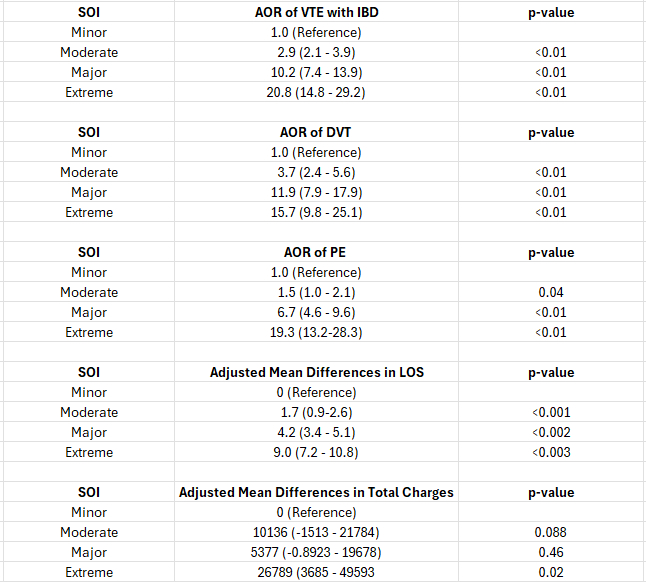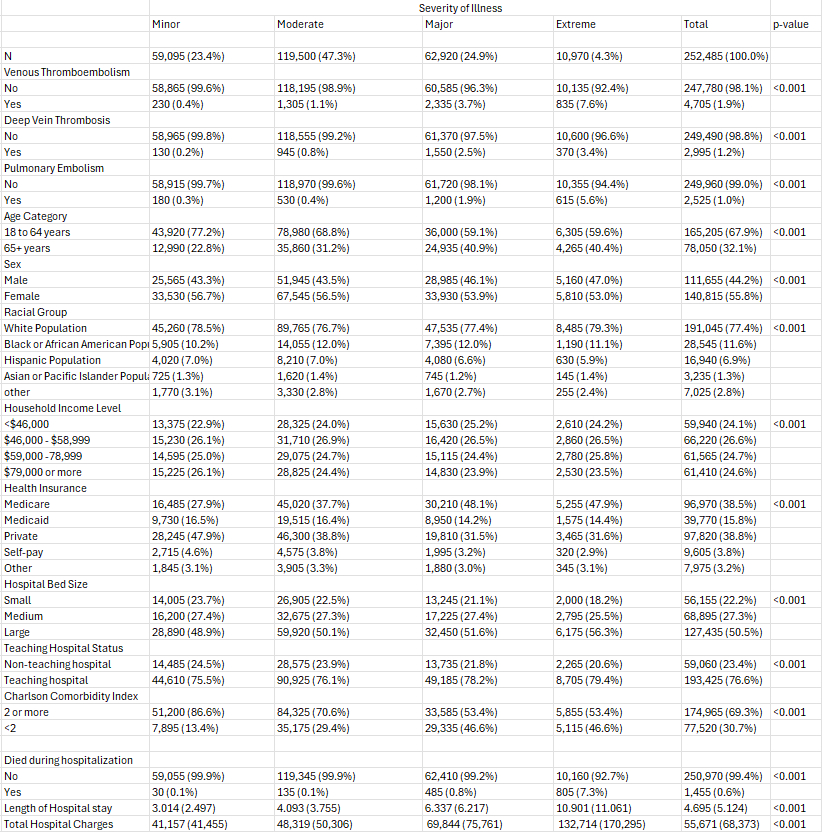Sunday Poster Session
Category: IBD
P1211 - Venous Thromboembolism in Patients With Inflammatory Bowel Disease: An Analysis by Severity of Illness Using 2020 National Inpatient Sample Database
Sunday, October 26, 2025
3:30 PM - 7:00 PM PDT
Location: Exhibit Hall
- KE
Kevin Eid, MD
MedStar Georgetown University Hospital
Baltimore, MD
Presenting Author(s)
Kevin Eid, MD1, Boniface Mensah, MBChB, MPh1, Greeshma Gaddipati, 2, Simardeep Singh, 2, Ramya Vasireddy, MBBS2, Terrylyna Baffoe-Benny, 2, Hasan Obiedat, MBBS3, Haider A. Naqvi, MD4
1MedStar Georgetown University Hospital, Baltimore, MD; 2MedStar Health, Baltimore, MD; 3Medstar Georgetown University Hospital, Baltimore, MD; 4MedStar Franklin Square Medical Center, Baltimore, MD
Introduction: Patients diagnosed with inflammatory bowel disease (IBD) are known to experience chronic inflammation of the gastrointestinal tract predisposing them to a higher risk of developing venous thromboembolism (VTE) compared to individuals without IBD. The use of VTE prophylaxis for hospitalized individuals with IBD is still a weaker recommendation. This study aims to explore the incidence of VTE in patients with IBD, graded by severity of illness (SOI) to assess its burden and to provide robust data that can inform clinical decision-making and enhance recommendations for VTE prophylaxis in this patient population.
Methods: We utilized data from the 2020 National Inpatient Sample (NIS) database, the largest inpatient care database in the United States. All the patients aged 18 and above with primary diagnosis of IBD were included in this study, identified by ICD-10 codes. Severity of illness (SOI) was defined using All Patient Refined Diagnosis Group (APRDRG) severity of illness: minor, moderate, major and extreme. The primary outcome studied was the incidence of VTE per disease severity. VTE was identified by the ICD-10 codes for deep vein thrombosis (DVT) and pulmonary embolism (PE). Baseline demographics of study participants were obtained. Logistic regression analysis was used to calculate odds of VTE in study participants based on SOI adjusted for baseline characteristics. Sampling weights were applied to generate nationally representative estimates.
Results: A total of 252,485 study participants were included in the study. The incidence of VTE increased with increasing SOI with incidence of VTE in patients with minor SOI being as low as 0.4% compared to 7.6% in patients with extreme SOI. The incidence of DVT and PE showed similar trends across SOI. The adjusted odds ratios of VTE in patients admitted with moderate, major and extreme SOI were 2.9 (95% CI: 2.1 – 3.9), 10.2 (95% CI: 7.4 – 13.9) and 20.8 (95% CI: 14.8-20.8) compared to that of patients admitted with minor SOI.
Discussion: This study shows an increase in incidence of venous thromboembolism with increasing SOI in patients with IBD. This emphasizes the need for inpatient VTE chemoprophylaxis in patients with IBD irrespective of the reason for admission, especially in patients with higher severity of illness to reduce morbidity and mortality associated with VTE.

Figure: Table 1: Baseline Demographics of Included IBD Patients

Figure: Table 2: Adjusted Odds Ratio of VTE by Severity of Illness
Disclosures:
Kevin Eid indicated no relevant financial relationships.
Boniface Mensah indicated no relevant financial relationships.
Greeshma Gaddipati indicated no relevant financial relationships.
Simardeep Singh indicated no relevant financial relationships.
Ramya Vasireddy indicated no relevant financial relationships.
Terrylyna Baffoe-Benny indicated no relevant financial relationships.
Hasan Obiedat indicated no relevant financial relationships.
Haider Naqvi indicated no relevant financial relationships.
Kevin Eid, MD1, Boniface Mensah, MBChB, MPh1, Greeshma Gaddipati, 2, Simardeep Singh, 2, Ramya Vasireddy, MBBS2, Terrylyna Baffoe-Benny, 2, Hasan Obiedat, MBBS3, Haider A. Naqvi, MD4. P1211 - Venous Thromboembolism in Patients With Inflammatory Bowel Disease: An Analysis by Severity of Illness Using 2020 National Inpatient Sample Database, ACG 2025 Annual Scientific Meeting Abstracts. Phoenix, AZ: American College of Gastroenterology.
1MedStar Georgetown University Hospital, Baltimore, MD; 2MedStar Health, Baltimore, MD; 3Medstar Georgetown University Hospital, Baltimore, MD; 4MedStar Franklin Square Medical Center, Baltimore, MD
Introduction: Patients diagnosed with inflammatory bowel disease (IBD) are known to experience chronic inflammation of the gastrointestinal tract predisposing them to a higher risk of developing venous thromboembolism (VTE) compared to individuals without IBD. The use of VTE prophylaxis for hospitalized individuals with IBD is still a weaker recommendation. This study aims to explore the incidence of VTE in patients with IBD, graded by severity of illness (SOI) to assess its burden and to provide robust data that can inform clinical decision-making and enhance recommendations for VTE prophylaxis in this patient population.
Methods: We utilized data from the 2020 National Inpatient Sample (NIS) database, the largest inpatient care database in the United States. All the patients aged 18 and above with primary diagnosis of IBD were included in this study, identified by ICD-10 codes. Severity of illness (SOI) was defined using All Patient Refined Diagnosis Group (APRDRG) severity of illness: minor, moderate, major and extreme. The primary outcome studied was the incidence of VTE per disease severity. VTE was identified by the ICD-10 codes for deep vein thrombosis (DVT) and pulmonary embolism (PE). Baseline demographics of study participants were obtained. Logistic regression analysis was used to calculate odds of VTE in study participants based on SOI adjusted for baseline characteristics. Sampling weights were applied to generate nationally representative estimates.
Results: A total of 252,485 study participants were included in the study. The incidence of VTE increased with increasing SOI with incidence of VTE in patients with minor SOI being as low as 0.4% compared to 7.6% in patients with extreme SOI. The incidence of DVT and PE showed similar trends across SOI. The adjusted odds ratios of VTE in patients admitted with moderate, major and extreme SOI were 2.9 (95% CI: 2.1 – 3.9), 10.2 (95% CI: 7.4 – 13.9) and 20.8 (95% CI: 14.8-20.8) compared to that of patients admitted with minor SOI.
Discussion: This study shows an increase in incidence of venous thromboembolism with increasing SOI in patients with IBD. This emphasizes the need for inpatient VTE chemoprophylaxis in patients with IBD irrespective of the reason for admission, especially in patients with higher severity of illness to reduce morbidity and mortality associated with VTE.

Figure: Table 1: Baseline Demographics of Included IBD Patients

Figure: Table 2: Adjusted Odds Ratio of VTE by Severity of Illness
Disclosures:
Kevin Eid indicated no relevant financial relationships.
Boniface Mensah indicated no relevant financial relationships.
Greeshma Gaddipati indicated no relevant financial relationships.
Simardeep Singh indicated no relevant financial relationships.
Ramya Vasireddy indicated no relevant financial relationships.
Terrylyna Baffoe-Benny indicated no relevant financial relationships.
Hasan Obiedat indicated no relevant financial relationships.
Haider Naqvi indicated no relevant financial relationships.
Kevin Eid, MD1, Boniface Mensah, MBChB, MPh1, Greeshma Gaddipati, 2, Simardeep Singh, 2, Ramya Vasireddy, MBBS2, Terrylyna Baffoe-Benny, 2, Hasan Obiedat, MBBS3, Haider A. Naqvi, MD4. P1211 - Venous Thromboembolism in Patients With Inflammatory Bowel Disease: An Analysis by Severity of Illness Using 2020 National Inpatient Sample Database, ACG 2025 Annual Scientific Meeting Abstracts. Phoenix, AZ: American College of Gastroenterology.

